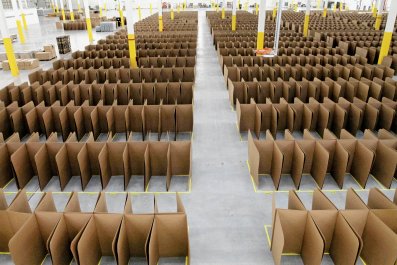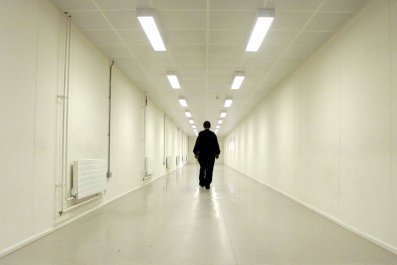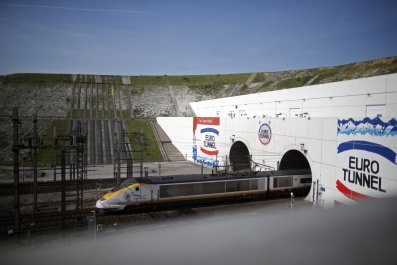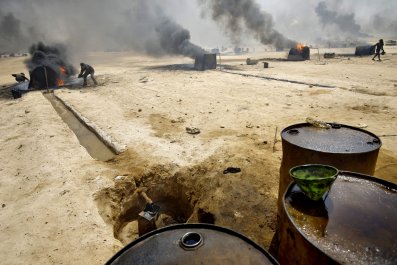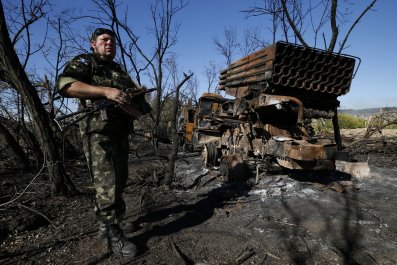"How do you get out of an Icelandic forest? You stand up."
During five days spent in Iceland this fall, I heard locals tell this joke several times.
The quip once made sense; Iceland was until recently a tree-deprived land, hosting instead an abundance of beautiful wide-open expanses, clad in volcanic rocks, glaciers and some grasses and shrubs. And while it still remains largely that way, trees and woodlands have been steadily returning the past several decades, and an Icelandic forestry industry is beginning to take root.
That's due in large part to a warming climate, which is helping many new types of trees grow here. Over the past 20 years, average temperatures have increased by almost 2 degrees Fahrenheit. As a result, trees are growing faster and new varieties are now found here that couldn't survive before.
Adalsteinn Sigurgeirsson, head of research for the Icelandic forest service, has heard the joke thousands of times. "[I] cringe every time I hear it," he says. Sigurgeirsson picks me up on recent Monday morning in Reykjavik in his black Mitsubishi pickup. It's rainy and the sky is dark—not ideal weather for walking through a forest. He's dressed in a blue sweater and green rain jacket. He smiles and nods at the deluge outside. "Welcome to Iceland!" The rain is usually moderate, he assures me, and it provides enough water for tree growth over much of the island—one reason he is so upbeat about forestry's prospects here.
The forest research center where he works is on the slopes of Mount Esja, a short drive outside of Reykjavik. On the way, we pass stands of black cottonwood on roadsides, coppices of birch and conifers dotting hillsides. "When I was a kid we had much fewer trees—it was common knowledge that trees couldn't grow in Reykjavik, and couldn't grow in Iceland," he says. "And now look!"
Once at the center, we venture into the nearby woods, where trees tower several stories above us. Sigurgeirsson explains that woodlands have many benefits in Iceland: they provide for more biodiversity, create opportunities for recreational activities and reduce soil erosion.
Newly planted forests have attracted colonies of goldcrests (Europe's smallest bird), woodcocks and long-eared owls to the area. These are all ecologically important species that add to the island's animal diversity, without being invasive and displacing native fauna. Woodlands also provide places for Icelanders and tourists to enjoy nature; one recently planted woods called Heidmork near the city now hosts 600,000 visitors per year.
Trees also help prevent soil erosion, which has ravaged Iceland for decades. One study suggested that if Iceland's rivers were forested, it would limit erosion and improve water quality enough that local populations of salmon would increase five-fold.
Long ago, before Vikings settled this North Atlantic isle in the ninth century, birch forests covered as much as 40 percent of the land. Unfortunately, the Vikings logged or burned most of the trees down within a few centuries. Then, as is common with volcanic soils with little vegetation, much of the land became eroded and barren, says Sveinn Runólfsson, director of the country's Soil Conservation Service. That helps explain why nearly a third of the country is now considered a "moist desert"—there is enough rain to support plants and trees, but the sandy black soil cannot provide adequate support for roots, and some needed nutrients were leached away long ago.
By the early 20th century, there were virtually no woodlands left in Iceland. But now, trees are coming back. Woodlands now cover 1.5 percent of the country, and 3.2 million trees were planted last year. Most of these trees were planted by farmers or landowners on private land. They've been largely funded by the government, which is spending to create forestry jobs, and to reap the rewards of benefits like erosion reduction, Sigurgeirsson says. This rash of planting began in 1990, and since then, more than 107 million tree seedlings have been put in the ground.
Most Icelandic trees are still too young to be cut down and turned into planks and boards for furniture and building materials. But thinning, which involves cutting down young trees in areas where they've become too thick, is already taking place, and is increasing every year, says Throstur Eysteinsson, Sigurgeirsson's colleague.
Much of the growth in forestry is made possible by warming, and temperatures are expected to increase by another 2.7 degrees by 2050, according to the Icelandic Meteorological Office.
Along with the warmer weather and consequently longer growing season, trees shoot up more quickly; forests are growing about 50 percent faster than they were when measured in the 1960s, Sigurgeirsson says. Meanwhile, new varieties are showing up and prospering. Twenty years ago, it would be difficult—if not impossible—to find valuable trees like oak, beech, rhododendron, apple, pear or cherry. But now these species are "beginning to flourish and the fruit trees have begun to bear fruit," Sigurgeirsson says.
"It's not nice to talk well about climate change," he adds, "and there have been bad consequences for many, but in Iceland it has helped forestry."
As temperatures warm globally, the distribution of trees on the planet generally shifts toward the poles. That sounds like it'd be good for any relatively barren country. But Iceland actually seems to be a special case. In many other treeless places, this sylvan migration has, perhaps counterintuitively, been linked with problems.
For example, according to one 2007 study in the Proceedings of the National Academy of Sciences, as temperatures rise, and the boreal forests (the name for woodlands that ring the Northern Hemisphere) march northwards, their southern edges may becoming increasingly deforested because new tree varieties sprouting up may not be able to replace those dying off quickly enough.
Climate change has also been linked to increased wildfires in the Arctic's boreal forests, Alaska, the American Southwest, Australia and elsewhere.
Meanwhile, droughts are expected to become more frequent and intense in a warming world, which is bad for forests in arid regions. And climate change has been linked with outbreaks of pests like mountain pine beetles, which have ravaged millions of acres of forests in the northwest United States and Canada.
But in Iceland, nobody's complaining. In fact, trees and forests have become something of the rage among the public. About 7,500 people (or 2.3 percent of the population) now belong to forestry associations, which help plant trees and educate people on the topic, said Ragnhildur Freysteinsdóttir, project manager of the Icelandic Forestry Association.
There is some pushback. Of the most commonly planted woodland-forming trees in Iceland—Sitka spruce, Russian larch, Alaskan cottonwood, lodgepole pine and birch—only this last species is native. And that concerns some, like Snorri Baldursson, a park manager at Vatnajökull National Park who wrote a book, Lífríki Islands, about the ecology of Iceland, who think the role of the service should be to "replant and reclaim natural birch forests, not plant exotics."
He said he's "worried about the impact exotics might have on biodiversity," such as out-competing the native birch, which is relatively slow-growing and short.
But in the absence of harm from exotics, and in a landscape that has been heavily altered by humans for more than a millennia, it isn't the most convincing of arguments. Those in the forestry community generally agree that the state of affairs is far from natural, and, according to Sigurgeirsson, planting exotics is necessary for a legitimate forestry industry since they grow much more quickly than native birch.
Besides, says Freysteinsdóttir, "on windy days, it's much nicer to be in a forest than on open land."










